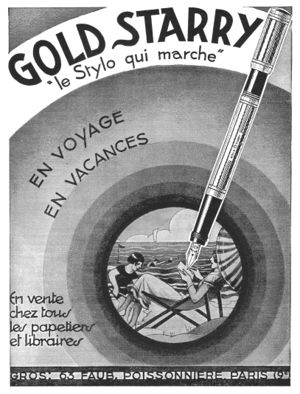Gold Starry
| Gold Starry |
|---|
| Brand pages |
| Brand advertising |
| Brand photos |
| Other documents |
| Patents |

Le origini della Gold Starry si fanno risalire al 1909 quando Maurice Jandelle iniziò la commercializzazione in Francia con il marchio Gold Star di penne della Conway Stewart. Questo marchio però era già stato depositato per cui nel 1912 venne trasformato in Gold Starry, con una scelta che rimarcava le origini inglesi delle penne, che vennero commercializzate fino al 1919. Le prime penne commercializzate dalla Gold Starry erano delle rientranti in ebanite nera o marmorizzata. I primi modelli, introdotti all'incirca nel 1913, erano stilografiche a contagocce o safety, identificate da due cifre (modelli 36 e 39), che indicavano il prezzo in franchi.
At the beginning of the '20s Paul Jeanvrin and André Petit began a fountain pens production in a pavilion on the outskirts of Paris. In 1921 the two joined Maurice Jandelle and the Gold Starry was established as a wholly-owned French company, starting its own fountain pens production and stopping the import of English pens. With manufacturing in France, the company adopted the slogan "the stylo qui marche", meaning both the dynamism than the reliability of their pens.
The first pens had were gold nibs and black or marbled hard rubber body, eyedropper filler with no clip. In 1925 were introduced 256 and 257 Loaded safety models, characterized by the trademark consisting of a star, the Manifacture Francaise engraving on the barrele and some dotted rings on the cap top. The pens were still without clip, which was introduced on the following model 254. In 1927 was introduced a lever filler model.
Gold Starry was one of the first French companies to use the celluloid getting excellent quality colored pens with vibrant colors and with gold plated finish and gold nibs, able to compete with imported American pens. Around 1929 the earlier models were discontinued and a new range of celluloid pens was launched, in black, red and white marble, lapis blue, cardinal red, green jade and jasper. There were also made some solid gold pens.
In 1931, with the search for a filling system that would allow a greater ink capacity, a particular model, the Rapex, was produced a twist filler, which, however, had little success for the delicacy of the system, and therefore is rather rare. In 1933 in Maurice Jandelle was replaced by M. Perouse, an executive of the company Viala Lilliput, producer of luxury pens in gold and silver enamel, which were also made by the Gold Starry. In addition, with the emergence of the streamlined style introduced by Balance, in the '30s the production of the Gold Starry passed from square shapes of the 20s to sleek lines. There remained the distinctive mark of the clip, jagged shaped and ending in a arrow.
During the war the company suffered from the obvious difficulties faced by all competitors, with perhaps the aggravation of having to support an English brand name. After the war, production was increased at the expense of quality, that was acceptable, but not up to the best time of the company. Like other producers Gold Starry suffered heavily the crisis from the ballpoint pen introduction, which it tried to react by building cartridge fountain pens and participating in 1959 to the consortium for the production of the Visor Pen.
The Gold Starry was able to move forward and overcome the crisis period with the differentiation of the production, goin in the market of luxury office accessories (with calendars, rulers, letter openers) produced in gold-plated metal. In addition, a line of luxury ball-point pens, always gold plated, had a remarkable success. The company, however, suffered heavily from the effects due to the blockade imposed on the gold price, which made its products too expensive then when it ceased sent it off market. Despite all the efforts in 1980 Gold Starry closed its doors.
External references
- https://web.archive.org/web/20091001201351/http://www.stylos-francais.fr/goldstarry.php
- https://web.archive.org/web/20140103135250/http://goldstarry.penandco.com/accueil_us.html